 BBC News
BBC NewsBorrowing was £17.4bn last month, the second highest October figure since monthly records began in 1993.
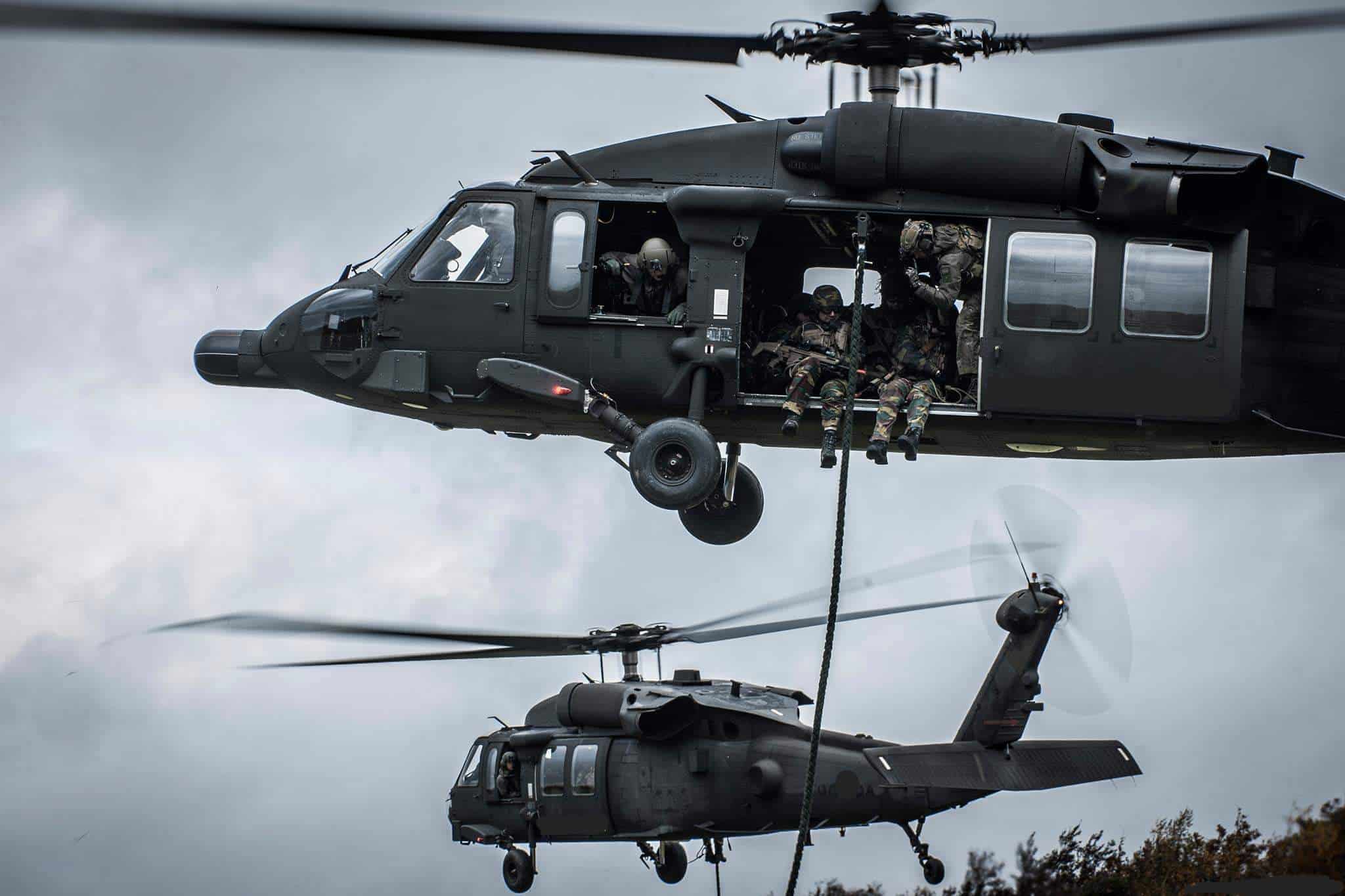
The Ministry of Defence is on the market for a new helicopter – one which can fulfil the roles of several medium lift helicopters currently in service. The New Medium Helicopter (NMH) programme has garnered bids from Airbus, Bell Textron, Sikorsky, and Italian-based manufacturer Leonardo so far, but the programme’s focus on both aircraft capability and UK economic stimulation leaves the most recent contender Team ML70 in a unique position.
Team ML70 was born from the British start-up AceHawk Aerospace. The company, which is now leading the project, proposes to refit and upgrade existing American UH-60 Black Hawk helicopters with larger engines, modern glass cockpits, and advanced avionics packages at their Teesside-based facility in the Northeast of England. We had the chance to speak with AceHawk CEO and experienced pilot Fionnán Collins.
“Most of my experience as a pilot is in search and rescue flying what’s called an S-92, which itself is kind of a development of the Blackhawk. It’s used by the Coast Guard in the UK and in Ireland, and I’ve flown in both, and I’ve also flown it in Norway,” Collins says, “I’m a pure civilian, but at the same time, a lot of my colleagues, friends, and people I’ve flown with are ex-military. Part of my draw to the Blackhawk airframe itself is because a couple of good friends of mine fly them for the fire departments in LA County and San Diego, so I have an understanding from them of what the capabilities of the Black Hawk are in those kinds of roles.”
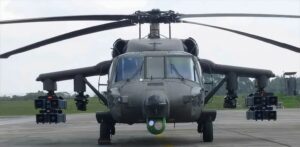
ML70 helicopter with armament package
The existing helicopters are being phased out not only due to their age, but also because of the increased training and maintenance costs which stem from having a variety of different types of aircraft in service simultaneously. It will always be cheaper to train pilots and mechanics on one airframe than on many, so it was decided that one helicopter should fill all medium lifting roles.
“You’ve got multiple different types there that are causing a drain on resources,” Collins says, “Having crews training on all different types costs money and takes time, so having one aircraft to do all of those functions saves so much grief. The RAF and the Army do exchanges with Brunei, Australia, and sometimes with other smaller users and send instructors to Fort Rucker in Alabama where they learn to fly the Blackhawk, so there is a base of knowledge in the UK already about this aircraft.”
Originally, the plan was to put these fully refurbished and upgraded Black Hawks into European firefighting roles, but Collins realised that regulations currently don’t allow the Black Hawk to fly commercially. Then, AceHawk’s prospects shifted towards the military.
“The initial trigger was the UK defence review in March 2021 which suggested that the Army and the Air Force had four different types of helicopter that needed to be replaced with one single type to do all of the different functions. The Black Hawk clearly is the aircraft that has been proven to do all the required functions, and that’s the big drive behind it as well – it’s a proven airframe. We sat down as a group of us, Damian, Darren, and I with a couple of our other guys, Mike and Simon. Both of them used to fly out of RAF Benson, and they said, ‘The RAF and the Army would have loved to have had the Black Hawk for years, is there a way to make this happen?’”
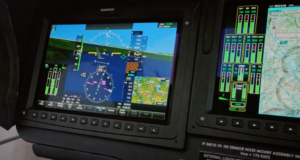
Garmin avionics on board the ML70
If accepted, the AceHawk ML70 would replace the RAF’s Puma HC2 and Bell 412 helicopters, as well as the Army’s fleets of Bell 212 and Airbus AS365 Dauphin aircraft. Collins explains the variety of functions the NMH will be expected to perform, and how their roles could be filled by the ML70.
“The main body of what it would replace is the Puma fleet, which does Troop Support, special operations, and a little bit of search and rescue as well. But what the government needs is an aircraft that can do even more. It needs to be able to do special ops, command and control, search and rescue in combat, medical evacuation, assault, and it needs to be able to do load lifting as well. The Puma could perform these functions to a point, but not at the level required. When the special ops guys have gone out on operations in places like Afghanistan and Iraq alongside the US Army, they always ended up flying in Blackhawks anyway. So they know what they want, and they know it is a proven and robust airframe which has filled all of these roles,” Collins says.
The NMH programme is not meant to produce a permanent or even long-term replacement for the helicopters currently in service. It is a stopgap measure to allow for the development and production of next generation rotor-driven platforms which they hope will be ready by the 2030s. However, it is more than likely that whatever helicopter is chosen will serve for longer than the 10 years projected, and Team ML70 says that they’re ready to take on the challenge of ongoing repairs.
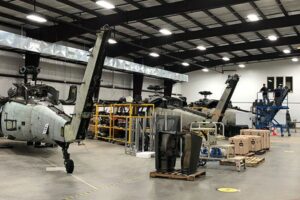
Stripped Black Hawks awaiting upgrades similar to those they will receive at Teesside
“The whole idea behind AceHawk Aerospace was not just the initial production of aircraft, it was support across the life of the project. The NMH project is suggested to be a 10-year function as a stopgap, but we believe it will need to go on longer, and we will be happy to support it for longer because that’s part of our business,” Collins says, “We will set up a facility that doesn’t just produce the aircraft but maintain them. And the support as well that we will get from General Electric who make the engines, and Garmin who would make the avionics solution is crucial to that. They are very keen and they’re absolutely going out of their way to support us on anything we need.”
Following the pandemic, the government is focussing their efforts toward spending more on British companies, so ministers have agreed that social value must be taken into consideration in regards to defence procurement. The non-UK based companies who have put in bids for the NMH programme are aware that at least a ten percent weighting must go towards that social value when considering any new defence contract, and each have made their own promises.
Airbus has pledged to create a production line of their proposed H175 helicopters at an existing facility in Broughton, Wales which currently produces wings for commercial aircraft. Leonardo plans on expanding their helicopter production efforts in Yeovil, Somerset if they win the bid with their AW149 offering. Bell-Textron, headquartered in Fort Worth, Texas, has requested that the MoD delay the NMH programme, allowing them time to field their next generation 525 chopper in place of the current stopgap plans.
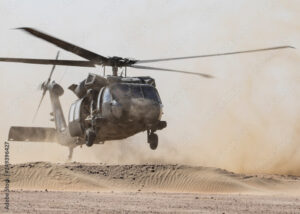
An ML70 lands in rough, dusty conditions
Sikorsky, who makes the Black Hawk, has put in an NMH bid offering brand new helicopters for the RAF and Army. In terms of both timeline and social value considerations, however, their offer is lacking. They propose that the new airframes be manufactured at their plant in Poland, then shipped over to Britain for modification. According to Collins, an already lengthy waiting list for new Black Hawks also poses problems.
It is worth noting that, of the existing offerings, Sikorsky and Team ML70 are the only companies not pitching converted civilian aircraft. Collins says that these options will be subject to a longer review period delaying delivery.
“We’ve put together a shopping list of mission systems with our supply chain and various partners, so it’s up to them to decide which ones they want and don’t want depending on what missions they want to do. But because of the history of the airframe and the missions that it has covered, there are lots of off the shelf systems that they can buy from proven suppliers. The majority of stuff out there has already been fitted to a Black Hawk airframe, so the UK doesn’t have to spend 12 months doing a trial if they’re willing to accept the data from other users. All of those different things can come quicker, because they don’t have to go off proving them themselves,” Collins says.
Aside from aircraft capability, there is also a strong political consideration at play. The Conservative government is likely more eager to place the economic stimulus which will be fostered by the NMH programme in the Northeast in hopes of breaking down the “red wall”. AceHawk’s Teesside-based production facility would require more employees to fill the order, thereby creating more jobs for County Durham and North Yorkshire residents and providing more opportunities for training.
“When we started this project, we knew that the politics were part of it, because they always have been. Helicopter procurement in the UK has always had that involvement all the way back to probably the 70s or 80s, but it’s something that we were aware of so we’re happy to engage. One of the big winners on that is basing ourselves at Teesside airport, which is owned by Tees Valley Combined Authority, which is a local council. That authority is run by Ben Houchin, who is a member of the Tory party. He is the local mayor, and he was the one who got Tees Valley Combined Authority to buy the airport from the holdings company who were not making a good business out of it. And he’s turned it around,” Collins says, “So that’s a member of the party who’s the local mayor who’s had the vision to say, ‘Hang on, we need this up here. We need jobs.’ And it’s that mindset that drew us to decide on Teesside when we were looking at places where we could do this.”
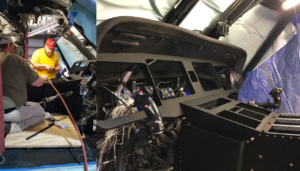
The cockpit of an ML70 before high-tech avionics are fitted
The next phase, which involves inviting the top five companies to negotiate, is set for the end of October at the earliest. The NMH contract will likely be awarded in mid-2023, with the chosen helicopter reaching the field at the beginning of 2025.